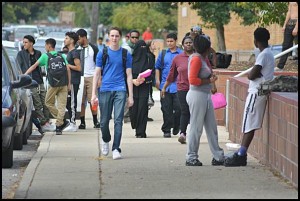With influx of new students, school district finances are making the grade

Public school officials are bracing for a huge influx of students this year, with a number of them coming from Yemen to escape the ongoing bombing. Most of the new students will first have to learn English.
By Charles Sercombe
It was not long ago the Hamtramck Public School District feared it was losing students at a pace that could have forced the closing of some schools.
This year, there could be a problem of finding space to accommodate students.
A large number of students have enrolled this year, many of them escaping the ongoing bombing happening in Yemen, said school officials.
An early count of students shows there are at least 100 more students this year compared to last year.
That number could conceivably increase by another 186 if all the students who enrolled for this year actually show up for class.
Hamtramck School Boardmember Jackie Starr said most of the students are refugees from Yemen and a smattering from Syria.
While the sudden increase is good news for the district, it does present a challenge.
“We have to find them housing,” Starr said.
The students must reside in the district in order to attend, she said. That will be no easy task as there appears to be a housing shortage in the city. There has been a steady flow of new people moving into the city in the past two years.
Hamtramck has long been home to newly arrived immigrants – and that is still true – but there is now an influx of adults moving here to escape high rents in midtown Detroit.
District Superintendent Tom Niczay said many of the new students will present another challenge to the district – teaching them how to read and speak English.
“The increase in enrollment is mainly due to English Language Learners from overseas spread out over several grades with grades, 9 and 10 being the grades most affected,” he said.
The ELL program caters to students who do not speak English or speak only a little of it.
If more students start to show up, Niczay said “classroom space could be an issue.”
“We are in the process of planning for possible room assignment changes if needed to create more room.”
The boom in the student population has its upside. The district receives $7,511 in state financial aid for every student.
The extra 100 students represent an additional $751,100 in revenue.
If all 286 students show up, the district will receive an additional $2.1 million in financial aid.
The influx of students wasn’t expected. School officials had braced for a loss of students this year.
Up until over a year ago the district was at the end of a five-year plan to climb out of a $5 million budget deficit, due mostly to severe cuts in state financial aid as the state slashed aid to schools and communities to combat its own budget woes.
The district successfully worked its way out of the deficit and now projects its current $6 million budget surplus — which in education parlance is also called a “fund equity” — to shoot up to $7 million.
Getting out of the financial crisis meant making some hard choices for district employees.
Teachers and others agreed to cuts while some employees such as custodians found themselves out of a job when the district decided to privatize that work.
Niczay said that although the district is now financially sound, there are projects that require funding.
“We have a decent fund equity, however, we have building repair needs, staffing needs and technology needs that need attention,” Niczay.
District employees who agreed to cuts have an agreement with the district to negotiate restoring their losses.
The district’s teacher union president, Michelle Cooke, said her union recently entered into a three-year contract with the district that included some raises.
The union plans to continue to ask for more of their lost wages to be restored, although the district is not obligated to take that action.
“We’re slowly edging back,” Cooke said about bringing their salaries back up. “But the district is very cautious for a number of things.”
While the economy and housing property values have improved since the housing crash in 2008, there is concern among state and national economic experts of another downturn.
One thing the district has going for it is the support of voters, who in recent years passed a sinking fund millage to allow various building repairs and also renewed the recreation millage for another 10 years.


guest
September 28, 2016 at 1:20 am
Please seize the opportunity. Build new modern schools. Give the kids more homework. Increase the school’s ranking. Otherwise the cycle will repeat itself within a few years when families start moving to other cities for better educational opportunities for their kids.
Sharkeisha Jackson
October 30, 2016 at 8:35 pm
With these new funds, Hamtramck should really take the opportunity to open a new school before a new charter school opens up and takes these new students.
There are plenty of large empty buldings that you can turn into large state of the art school. In addition to the surplus funds you can apply for extra grants towards this initiative.